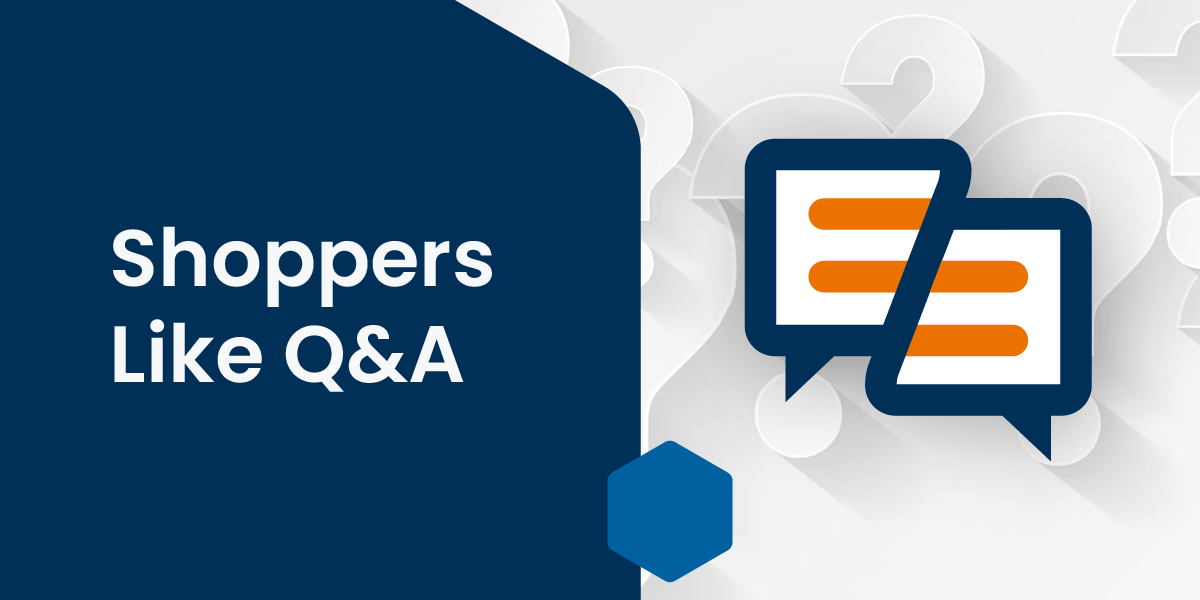What Shoppers Like About Online Q&A
Table of Contents
Introduction: Why Do Shoppers Like Q&A?
Q&A is important for shoppers because, like an FAQ page, it provides a place for customers to go to find answers to common questions. Having these answers readily available allows customers to get fast facts without the need to reach out to the customer service department.
I myself am a frequent online shopper and can attest to the fact that seller websites with an extensive Q&A section are more convenient to use. I appreciate that Q&A provides instant and easy answers to many of my questions. Even faster and easier than a chat feature, which I often find time-consuming and cumbersome.
If I find that a seller hasn’t provided a Q&A page to address common questions, I am likely to leave the site and continue searching for another similar product that clearly displays the information I need to make my decision about a product.
The lack of Q&A leads me to question the dedication to their customers, the quality of the company, and the quality of the product if the site isn’t up-front about crucial details and makes no effort to provide easy access to answers.
My time is valuable, and I won’t waste it hunting down answers that are readily available through a different company’s website or product Q&A. In my opinion, a product page without a searchable Q&A or FAQ may be a deal-killer, depending on the product and price.
If it’s a specialty item or something with a high price tag, such as computers or other technical gear, I may be more willing to take a little time to do some research. However, if another product highlights the details I’m looking for, I will always choose that one first.
In other words, if I am concerned about very important and specific product qualities or characteristics, such as fit, feel, usability, assembly, compatibility, age appropriateness, return policy, warranty, etc., then I require those questions to be displayed prominently and addressed to my satisfaction quickly, without the hassle of searching them out.
What Specifics Do Shoppers Like to See in Product Q&A?
Here are some of the things that a website can and should offer to save me time and show that they care about me and my business:
- Product reviews
- Searchable product Q&A or FAQ (Please don’t make me scroll down a long list of questions to find what I am looking for.)
- High quality, detailed product images from various angles
- The relative scale or size, using a common product as a comparison
- Product videos showing it in action
- Source of the materials and finished product
- Production method
- Clear return policy information
- Warranty or guarantee information
- Information about shipping options, costs, and timing (tracking is also nice)
- The pros and cons of the product (Give me the real story so I know what I am in for, and what to expect.)
- Incentive programs or discounts
- Standardization and the product’s compatibility with other brands and models
- Length of time the company has been in business and has produced the product
- Accepted payment methods
- Site and payment safety and security
As a regular online shopper for my family, my product needs span several age and gender ranges. I research and buy a lot of different types of products and services, including clothes, electronics, toys, games, gifts, personal care, home decor, bedding, and more. This means that I am going to have a lot of questions about a wide variety of products. Some general, and some very specific.
Moreover, because I am a working mother and wife, my time is limited and precious. I don’t like wasting time or shopping on sites that don’t value my time. I’ll redirect my search efforts and spend my money on a site that makes the buying experience easy and pleasant.
What Attributes Do Most People Find Helpful in Product Q&A?
Q&A is most helpful when it is easy to find, simple to navigate, and it contains relevant links.
Along with the Q&A being displayed prominently so it’s easy to find and access, I like it when the information is searchable. This way, I can find the answers to my questions without wasting time scrolling through pages of information, or waiting for chat help.
In general, I’m not willing to wait. I would rather be able to read up on the answers to my questions at my convenience. If this isn’t an option, I am likely to skip over a product and look for another that suits my needs.
A good searchable Q&A tool is self-serve, meaning I can access it at any time that is convenient for me. My busy schedule means that I am typically occupied with other tasks during normal business hours and do my online shopping later in the evening, so being restricted to direct communication could mean I can’t make the time to call and get the answers I need for several days.
I much prefer an online Q&A tool to online chat or customer service phone support. Chat features are often slow, require several attempts to get the answers I am searching, and often the answers are partial or incomplete. I have learned not to use chat if I can help it.
Another great Q&A feature is for companies to include relevant links within the answers. These could lead back to the purchase page, product videos, contact page, or additional resources that provide further details on the product.
Where Does Product Q&A Fit into the Buyer Journey?
I feel that Q&A has a place in every stage of shopping and buying, so it should be easily accessible at any time. However, a buyer’s questions become more complex the closer to purchase, so the content of the Q&A needs to be organized in such a way as to go from basic to progressively more detailed answers.
It’s nice to see the content of the Q&A reflect the stage of the buying journey I am in.
For example, when I’m first learning about a more complex product, perhaps some kind of electronic device, I want easy answers to the basics, such as what the product does, the cost, ease of use, quality, options for customer service in case of problems, and why a particular company’s product is the best option.
This is the initial stage where I need to decide if the product in question suits my needs, so I prefer to see answers to these initial questions in the search results and on the home page. A more basic product purchase, such as a small kitchen appliance, would need information on price, color, size, and function at this stage.
Once I have a good idea of whether I am interested in learning more, I expect to get additional details on the product specifications, applications, and more technical aspects such as the type of processor, memory, and software included. Other types of products could contain details like the type and number of batteries needed.
This is where I decide if the specific model is a good fit for my intended use, preferences, and needs. These types of details are best reserved for the Q&A on the product page.

I think Q&A should always be easy to find. Displaying these frequently asked questions and answers in a central location is one option. To save space and avoid clutter, a clickable link or drop-down menu is another great option to reference pertinent questions while browsing a web page.
Q&A information can be broken down into relevant questions pertaining to the buying stage, such as basic details shared on social media and search results and more in-depth answers on the product page.
If a single Q&A list is used, it’s best to organize content from basic to complex from the top down. This makes it easier to find relevant information. The bottom line is that if I have unanswered questions, I’m not going to complete a purchase, especially for anything that costs upwards of $100.
How Can Product Q&A Provide a Better Customer Experience?
What I want to see most is Q&A that is accessible for mobile devices, along with clear, detailed answers. I want answers that start with the basics and explain everything. I prefer it when a site uses friendly, conversational language that is easy to understand instead of relying upon dry facts or using language that is too technical to follow.
My daily life involves a lot of running around. I’m almost always on the go, taking one child to play practice, picking another up from after-school sports activities, or heading to a doctor’s appointment. This means I find myself with a few minutes here and there throughout the day that is spent waiting, with only my phone to occupy my time.
For this reason, I need a webpage and the crucial Q&A section to be mobile-friendly. I do a lot of my initial research and product exploration during these times. If a page is slow to load, or difficult to use on my phone, I’ll usually bypass that product and move on to something else.
The company should assume I don’t have prior knowledge of the product and do require a full explanation.
Q&A can be organized progressively to give those familiar with the basics the option to skip over the introductory questions. Providing accompanying videos to further illustrate a product’s features and uses is also beneficial in my opinion.
Many of my product buying decisions came as a direct result of perusing a Q&A. For example, I’ve recently had to pass on a bookshelf that exceeded the dimensions I had room for, although the readily available information saved me time. I’ve left a webpage for a space heater when I couldn’t immediately find the voltage required for the outlet.
Other times, the wealth of information makes my buying journey easy. The Q&A for my dog’s new indoor bed told me everything I needed to know about the size, material, and cleaning instructions. The fact that the FAQs mentioned that the materials used are excellent for senior dogs with arthritis made it an easy purchase for me.
What Recommendations Do I Have for Online Businesses Regarding Q&A?
My main recommendations for online businesses are to make sure Q&A gets the attention it needs, to provide plenty of information, and to focus on user experience. Businesses would do well to spend time developing their Q&A pages to ensure they are thorough, up-to-date, and easy to navigate to find pertinent information.
Online businesses need to be aware of how important product Q&A is to me and other shoppers. Having access to top FAQs and answers can mean the difference between me making a purchase and clicking off a webpage immediately.
Recently, when I needed a new laptop, I ran into some issues that directly influenced my final buying decision. I can say with confidence that had I not experienced these problems, I would have continued to consider the first laptop. As it was, my frustration became so great that I left the site and had a satisfactory experience with another product that met all my requirements when it came to Q&A, specs, customer reviews, and personal preferences.
One of the best recent buying experiences I had was my search for a multi-functional instant pot. All I had to do was a Google search for the features I was looking for and a range of products came up. I chose the product that listed the main features and provided the size within the search results. After clicking on the answer, I discovered further information that verified the product met my needs and went through with the purchase. The whole experience was fast, simple, and convenient.
Conclusion
Q&A is just as critical to my online shopping choices as customer reviews and product descriptions are. When a company doesn’t have instant access to answers available for commonly asked questions, it makes me wonder why.
Is there a known problem they are trying to cover up? Do they wish to avoid talking about flaws and issues with the product? Or do they not value their customers’ time and business enough to anticipate their needs?
I find that online businesses that make the effort to provide a Q&A section typically have high-quality products that live up to expectations. If I can find answers to my questions quickly, I often follow through and make a purchase. If I’m left unsatisfied, I’ll leave that company’s webpage and take my business elsewhere.
If you want help adding questions and answers to your website, you may want to look into a software service company that specializes in Q&A. There are multiple options, among which is Shopper Approved.
Here is some information Shopper Approved gave me about their Q&A software to help you learn more:
How Shopper Approved Can Help with Q&A
Shopper Approved has a Q&A tool designed specifically to help ecommerce businesses provide answers to their customers and then leverage those answers to attract new customers to their website.
With Shopper Approved Q&A, you can streamline customer service by answering the literally frequently asked questions you receive again and again, saving time, resources, and money.
Shopper Approved's Q&A software will optimize all of your questions and answers to be crawled and indexed by search engines and appear in the featured snippets that Google shows on the results page.
Curious about other traffic and conversion tools that complement Q&A?
Further Reading

 Drive More Visibility, Traffic, and Sales
Drive More Visibility, Traffic, and Sales
